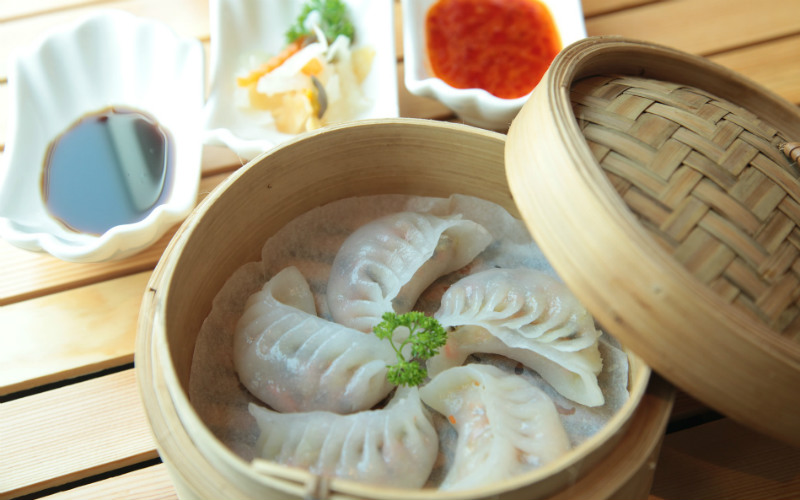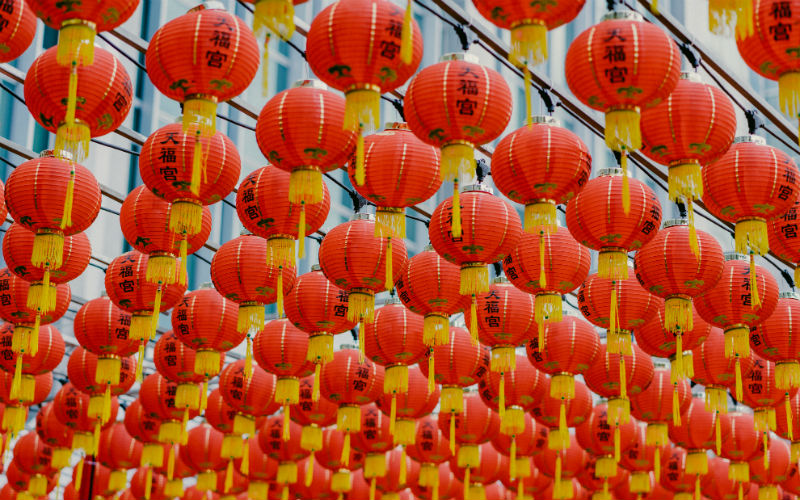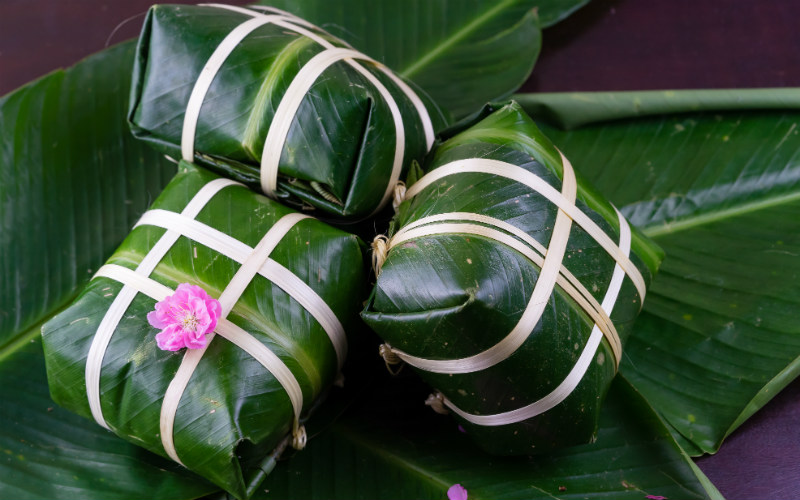Ringing New Year: How To Get Good Luck During New Year's Eve In Asia
From the ultimate guides of each destination, secret beauties, amazing things about food and culture to top suggested resorts and hotels, our travel blog is meant to help you travel Asia at ease and experience the best moments there without any hesitation.
Of course, not all Asian countries ring in the new year the same way or at the same time. There are dozens of unique traditions in the region so stick to these rules to make sure you have a great time during your journey.
CHINESE NEW YEAR DO's and DON'Ts: RED YOUR CLOTHES
Chinese New Year, also known as the “Spring Festival” is the biggest and most important festival in China. It is centuries old and gains significance because of several myths and taboos. While many people know that red is associated with luck and prosperity in Chinese New Year, there are dozens of dos and don’ts that you might never hear of.
DO’s:
1. Eat dumplings: In Chinese, the shape of a dumpling resembles a piece of gold that was used in China ancient times. So a bowl full of dumplings symbolizes wealth will come to you in the coming year.
The shape of a dumpling resembles a piece of gold in China ancient time (Image by jonathanvalencia5 from Pixabay).
2. Clean your house: Do anything and everything to make sure your house is clean before midnight of Lunar New Year's eve. This is to get rid of your home any bad luck that is accumulated over the past year.
3. Red the color: Bright red clothes, ornaments and house decorations are a sign of good fortune and happiness in Chinese New Year.
Red color is a sign of good fortune and happiness in the Chinese New Year (Image by bady abbas from Unsplash).
DON’Ts:
1. Don’t sweep your house: It means you are sweeping wealth away.
2. Don’t wash hair: In Chinese, hair has the same pronunciation as fa in facai, which means “to become wealthy”. Therefore, if you wash your hair, you are washing your fortune away.
3. Don't eat porridge in breakfast: Chinese people think that only poor people have breakfast with porridge, and surely that they don’t want to be “poor” in the new year.
4. Don’t visit your parents if you are married: The Chineses believe that a married daughter will bring bad luck and cause financial difficulties to her parents if she comes to visit them on the first day of the New Year. But the second day is fine.
5. Don’t wear clothes that are damaged: If the children wear torn clothes, they will bring bad luck to their families.
6. Don’t let other people take your money: If a thief steals money during the New Year, it is believed that you will be stolen in your whole new year.
7. Don’t buy books: Avid readers will have stock up their books before the New Year if they want to read, or they will have to wait until 15 days festival is over to visit a bookstore. In Chinese, the word “book” is pronounced shū, sounds exactly the same as "lose". So buying a book is an invitation to bad luck. Also, avoid giving a book as a gift to your family or friends because of the same reason.
TET NGUYEN DAN, VIETNAM: GIVE ANYTHING RELATED TO NUMBER 6 OR 8
Tet Nguyen Dan or Vietnamese New Year has the date falling in January or February. Tet in Vietnam is generally celebrated on the same day as Chinese New Year. Vietnamese people prepare for Tet by worship their ancestor, clean the house and cook special foods as Banh Chung, Canh mang (dried bamboo soup), Nem, and sticky rice. But Tet has some traditional taboos that can be complicated and confusing, even for Vietnamese people. You might need to know about them if you are planning a trip to Vietnam during the holiday.
Family members gather to cook Banh Chung or Banh Tet - a special traditional food in New Year festival
DO’s:
1. Say “Chuc Mung Nam Moi”: Means “Happy New Year” when you see any Vietnamese with a big smile as well as good luck wishes such as “Van su nhu y”, means “May everything goes as you wish”, “An khang thinh vuong”, means “Wish you peace, good health and prosperity”
2. Smile often, and be energetic: It means you start your new day with happiness.
3. Give anything related to number 6 or 8: Number 6 in Vietnamese sounds like “Loc” which means Luck, while number 8 sounds like “Phat” which means Prosperity.
4. Visit temples to pray for a safe and happy new year
5. Pay all your debt before the last day of the old year if you don’t want to be in debt in the coming year.
6. Give Li Xi or lucky money: Slip a new, clean note into red envelopes and hand them to children and old people. Don’t forget to wish them health and happiness.
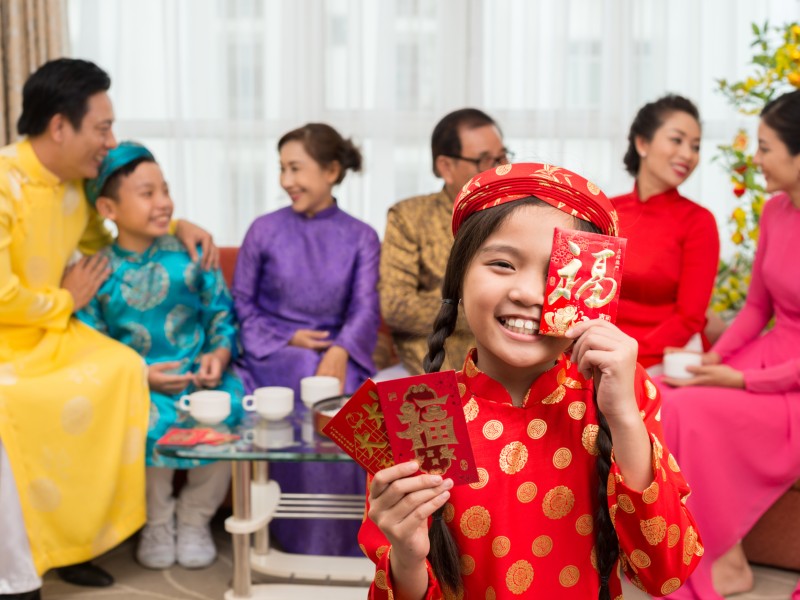
Lucky money hands to children and old people
7. Dress in bright color clothes: Keep things colorful and you can expect a glorious future ahead
8. Buy salt: Buying a small bag of salt is highly recommended in the New Year's Day, based on the belief that you will have a "tasty" energetic year. But don’t buy too much if you don’t want your new year “too salty”.
DON’Ts:
1. Don’t make unexpected visits to friend’s houses, you might be blamed for bringing them bad luck. Vietnamese is very serious about their first guest of the year and often invite someone whose age is suitable for their house owners’ age.
2. Don’t either borrow or lend money: People fear that financial arrangements make at the start of the year will persist for the rest.
3. Don’t wear dark colors because they are seen as omens
4. Don’t swear or argue because bad words and bad attitudes will bring bad luck to Vietnamese beliefs.
5. Don't sweep houses: Just like the Chinese taboo, Vietnamese people don’t sweep their house on the first 3 days of the new year because they think that all their money and success will be swept out too. But you can sweep from the front door to the kitchen, it means bringing money back into the house
6. Don't break glassware: Unless you want to have a “broken” year, be careful with your dining ware.
SONGKRAN, THAILAND - READY TO GET WET
Thailand celebrates New Year in Buddhist calendar so it comes later than its neighbors like China or Vietnam, in April. Thai’s New Year, or Songkran, is the biggest festival of Thai people with rich traditions. Locals visit temples, offer food to the Buddhist monks, clean Buddha statues and pay respect to the elder by pouring scent water over their hands. Songkran has another name is the water festival. This comes from a belief of Thai people: Water will wash away bad thought and action of the old year and bring good luck in the new year. But nowadays, it is famous worldwide when locals and travelers rush to the street, spend whole days splashing water on each other, make it the largest “water fight” in the world. That means you need to remember some Dos and Don’ts to survive the battle.

Songkran has another name is a water festival, means you will get wet
DO's:
1. Say “Sawasdee Pee Mai” to locals to wish them a happy new year.
2. Use public transport to avoid traffic hassles during the festival.
3. Leave phones and cameras at the hotel or put them in a ziplock bag for their best chance of surviving. You just need to have some extra cash.
4. Wear a swimsuit underneath your clothing if possible. Thai culture is a bit conservative so when your wet clothes stick to your body might irk the locals.
DON’Ts:
1. Don’t wear shoes: Floors are all wet during Songkran, so it’s better to wear sandals or flip-flops with firm grips to the ground to avoid an accident and protect your nice shoes.
2. Don't wear too much makeup: Since it’s a water festival so you ladies don’t want your makeup is swept away by a splash of water. Keep things minimal and waterproof.
3. Don't use banned equipment. Stick to legal tools such as small water buckets and light water guns.
4. Don’t throw water at monks, babies or the elderly.
5. Don't over drink and watch out drunken behavior in public: Getting too rowdy and aggressive is the worst idea during the festival.
6. Don't throw water at motorcyclists. It may unbalance them and cause accidents.
JAPANESE NEW YEAR: DECORATING YOUR HOUSE WITH KADOMATSU
Although the Japanese New Year celebrates the same days with the Western one, it is quite different. New Year in Japan isn’t marked by noisy activities such as countdown parties or fireworks, it’s more a quiet, solemn, family affair. As special as its culture, there is a long list of things to do in the New Year in Japan that may be completely new for visitors.
1. Invite good luck into your house with Kadomatsu and Shimekazari.
Kadomatsu is placed at the entrance, consist of 3 bamboo shoots of different lengths (symbolizing prosperity), pine (symbolizing longevity), and plum branches (symbolizing steadfastness). Japanese people believe that the Gods will stay on Kadomatsu when visiting their house. Shimekazari, which consist of shimenawa (a straw rope), pine, and bitter orange (a symbol of posterity), is hung above doors, to welcome good fortune of Toshigami or Shinto deity and banish evil spirits.
2. Serve Gods Kagami Mochi
Kagami Mochi is two round rice cakes in the shape of mochi cakes stacked one on top of the other and topped with an orange. Kagami Mochi is placed on the Shinto altar to wish for a good year and prosperity.
3. Eat Toshikoshi-Soba
One hour before coming to New Year, the Japanese often eat Soba, a traditional Japanese noodle. Because Soba is soft and easy to cut to they believe that eating Soba help cutting off of the last year’s misfortunes and wishing for a new wonderful year.
4. Ring the bell - Joya no kane
Joya no kane is a ritual in temples to ring a large bell 108 times. In Buddhism, 108 is the number of desires that cause humans much suffering, and Joya no kane is supposed to reduce the evil passions such as anxiety, fear, anger, jealousy, depression,.. out of humans’ minds and souls for the year up ahead.
5. Do Hatsumode
Hatsumode means making your first shrines visit to wish for prosperity, safety, and good health or whatever you like to come in New Year. Any visit later than the first week of January isn’t considered Hatsumode anymore.
People go to visit shrines to wish for prosperity, safety, and good health
6. Send Nengajou or New Year’s postcards.
The end of December and the beginning of January is the busiest time for post offices in Japan. Japanese people have a tradition to spend New Year’s postcards to distant relatives or friends.
7. Give Otoshidama
Otoshidama is a custom of giving money to children during the New Year. Money is handed out in small decorated envelopes called pochibukuro.
SEOLLAL, KOREA: KNEEL ON THE FLOOR TO PERFORM SEBAE
Seollal, or Korean Lunar New Year, is typically a family holiday. Many return to their hometowns to perform charye or an ancestral ritual and visit their parents and relatives. Koreans wear hanbok - a traditional dress, do seh bae (a deep bow to the floor) to deceased ancestors, make traditional food and drink and wish each other blessings for New Year. These are some Korea customs for you to know Seollal on a deeper level.
1. Charye - The ancestor-memorial ceremony
The first day of New Year begins with charye. Family members wear hanboks and gather in front of a table prepared for the ancestral rite with ritual food such as tteokguk, rice, meat, seafood, fruits, liquor, and vegetables. People will begin the ceremony with a deep bow to express gratitude to ancestors and pray for the family’s well-being in New Year.
2. Sebae - The New Year’s bow
Sebae is a traditional bow of respect to one’s seniors. Dressed in hanbok, the young folks kneel on the floor and extends their arms outwards. Men place their left hand over their right hand while women do opposite and perform a deep bow to the elders and say “Sahae bok mani badeuseyo”, which means “I wish you many blessings this year.”
3. Sebaetdon - The New Year’s money
After the children perform Sebae to their grandparents, uncles, and aunts wishing them good health and good fortune, elders will give them lucky money in a small silk bag as well as some words of wisdom.
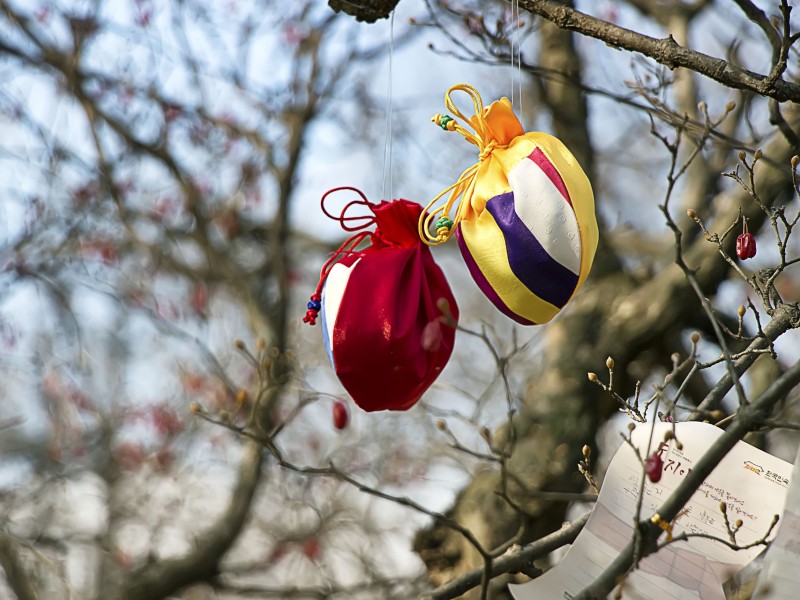
Elders will give their grandsons lucky money in a small silk bag as well as some words of wisdom (Image by 이정임 lee from Pixabay)
4. Tteok-guk - The rice cake soup
In New Year holiday, Koreans make tteok-guk, a traditional rice cake soup. They said that one must eat a bowl of tteok-guk to become one year older.


